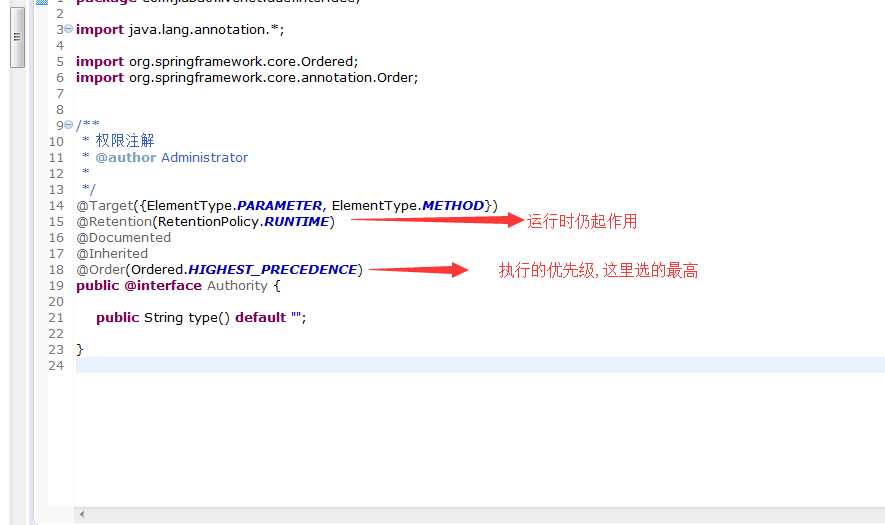标签:let 代码 one image before 无权限 mic 推荐 print
springaop属于spring的重要属性,在java中有相当广泛的用途,大家一般都接触过aop实现事务的管理,在xml里配好声明式事务,然后直接在service上直接加上相应注解即可,
今天我们来实现下SpringAOP的自定义注解,用来在前置通知中做下权限校验,有利于我们代码的解藕,提高复用性,增加代码B格;
话不多说,上代码,首先定义一个自定义注解

这里的参数我们并没有在使用,先随意定义个type,以后想使用时可以再赋值
再来看切面
import java.util.HashMap;
import java.util.List;
import java.util.Map;
import javax.annotation.Resource;
import javax.servlet.http.HttpServletRequest;
import org.apache.commons.lang.StringUtils;
import org.aspectj.lang.JoinPoint;
import org.aspectj.lang.ProceedingJoinPoint;
import org.aspectj.lang.annotation.After;
import org.aspectj.lang.annotation.AfterReturning;
import org.aspectj.lang.annotation.AfterThrowing;
import org.aspectj.lang.annotation.Around;
import org.aspectj.lang.annotation.Aspect;
import org.aspectj.lang.annotation.Before;
import org.aspectj.lang.annotation.Pointcut;
import org.slf4j.Logger;
import org.slf4j.LoggerFactory;
import org.springframework.stereotype.Component;
import com.jiubao.common.core.cache.redis.JedisUtil;
import com.jiubao.common.core.exception.MyException;
import com.jiubao.livenet.cache.JiuBaoCache;
import com.jiubao.livenet.constant.ServiceConstants;
import com.jiubao.livenet.enums.Limitsenum;
import com.jiubao.livenet.service.CustomerService;
/**
* 注解切面
* @author Administrator
*
*/
@Aspect
@Component
public class AuthorityAspect {
private static final Logger logger = LoggerFactory.getLogger(AuthorityAspect.class);
@Resource
private CustomerService customerService;
//Controller层切点
@Pointcut("execution (* com.jiubao.livenet.controller.*.*(..))")
public void controllerAspect() {}
/**
* 前置通知
* 只拦截带有Authority注解的controller方法
* @param joinPoint 切点
* @return
*/
//@org.springframework.stereotype.Controller *) 表示拦截controller方法 @annotation(Authority) 表示只拦截带此注解的方法
@Before("within(@org.springframework.stereotype.Controller *) && @annotation(Authority)")
public void doBefore(JoinPoint joinPoint) throws MyException {
logger.info("==========执行商户权限controller前置通知===============");
Object[] args = joinPoint.getArgs();
HttpServletRequest request=null;
for (int i = 0; i < args.length; i++) {
Object object = args[i];
if(object instanceof HttpServletRequest) {
request=(HttpServletRequest) args[i];
break;
}
}
Map<String, Object> paramMap = new HashMap<String, Object>();
if(request ==null) {
return;
}
String url = request.getRequestURI().toString(); //请求的url
/**
* 权限控制
*/
JedisUtil jedis = JiuBaoCache.getJedisUtil();
String userId = jedis.getUserId(request);
paramMap.put("uid", userId); //登录人UID
boolean isAccess=false;
List<Map<String, String>> userAuthlist= customerService.getUserAuth(paramMap); //查询登录人的商户角色列表
for (int i = 0; i < userAuthlist.size(); i++) {
if(userAuthlist.get(i).get("role")!=null) {
String[] limitsArray = Limitsenum.limitsArray(Integer.valueOf(userAuthlist.get(i).get("role"))); //使用枚举得到此角色对应的URL数组
for (int a = 0; a < limitsArray.length; a++) {
if(url.contains(limitsArray[a])) { //判断是否有,如果有则跳出
isAccess=true;
break;
}
}
if(isAccess) {
break;
}
}
}
if (!isAccess){
throw new MyException(-1,ServiceConstants.NO_ACCESS); //无权限访问,如果没有权限直接扔出个自定义异常,在那里会用response返回给前端提示
}
}
//全部拦截,这样的before就是全局拦截,会拦截所有方法
@Before("controllerAspect()")
public void doBefore2(JoinPoint joinPoint) {
System.out.println("==========执行全部拦截controller前置通知===============");
}
}
再看看调用过程
直接加在controller里想要限制的方法上即可

上面就是全部逻辑了,还有after和Around注解在此省略,这里要开始测试了,我几次都测不通,发现根本无效,而且
我配置文件里也有 <aop:aspectj-autoproxy proxy-target-class="true" />,不知道怎么回事,后来才发现
如果你的配置文件是这样的:

你除了在spring-mybaits.xml里要有这个外,还需要在spring-mvc.xml里有,好吧,都要加上才有效,而且别忘了头部的声明哦
顺便鄙视一下springmvc,配置文件就是麻烦
在此就完成了所有代码了,亲测是有效的
需提醒是的,当一个切面里有多个同样的注解时,会按链式分先后执行,比如上面第1个before,所有配了@Authority的方法会执行,接着执行第2个before,
而没有配@Authority的方法会直接执行第2个before,第1个由于不满足条件不会执行,这样方便我们在一个切面里写多种灵活的逻辑.
springaop由于配置灵活,复用性强,无性能损耗,在封装代码上很好用,比拦截器更方法,推荐使用
再推荐几个这方面比较好的文章:
1.https://www.cnblogs.com/jianjianyang/p/4910851.html
2.https://www.cnblogs.com/sjlian/p/7325602.html
3.https://www.cnblogs.com/mouseIT/p/5033746.html
标签:let 代码 one image before 无权限 mic 推荐 print
原文地址:https://www.cnblogs.com/lpcyj/p/9733027.html